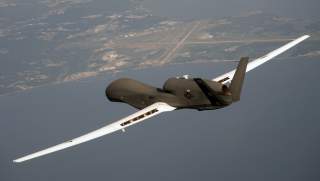Drone Shoot-Down Won’t Stop U.S. Patrols Near Iran
Retired U.S. Air Force general David Deptula, dean of the Air Force Association’s Mitchell Institute, told Air Force magazine he would put an additional Global Hawk “in the exact same track.” “We certainly don’t want to be cowed,” Deptula said.
Iran’s destruction of a U.S. Navy Global Hawk surveillance drone over the Strait of Hormuz on June 20, 2019 shouldn’t deter U.S. forces from monitoring the strategic waterway, officials said.
Retired U.S. Air Force general David Deptula, dean of the Air Force Association’s Mitchell Institute, told Air Force magazine he would put an additional Global Hawk “in the exact same track.” “We certainly don’t want to be cowed,” Deptula said.
Northrop built four Broad-Area Maritime Surveillance-Demonstrator drones, based on the Global Hawk platform, for the Navy starting in 2008. The Navy has stationed two of them in the United Arab Emirates for operational use as it prepares to deploy the full MQ-4C naval version of the Global Hawk starting in late 2019.
While it can fly as high as 65,000 feet, beyond the reach of many air-defense systems, the BAMS-D is subsonic and lacks stealth features, making it vulnerable to the most powerful surface-to-air missiles. Iranian forces claimed they used a version of the Buk M1 road-mobile SAM to shoot down the BAMS-D. The IRGC also possesses Russian-made S-300 air-defense systems.
Air Force chief of staff Gen. David Goldfein on June 26, 2019 told Air Force that American military aircraft would continue patrolling the Persian Gulf. “He doesn’t expect to significantly change the combination of assets in the region, noting it’s his job to pull together combat options for Pres. Donald Trump, if needed,” Air Force explained.
“We continue to fly where we need to be, when we need to be there, as we do in all scenarios,” Goldfein said. “This is a conversation we could have anywhere in terms of international air space. … We continue to protect those global commons for everyone and we continue to operate where we need to operate.”
Deptula said the Pentagon must modernize its “geriatric air force with systems that have been designed to operate against high-threat capabilities like stealth fighters, bombers and [intelligence, surveillance and reconnaissance] aircraft.”
“The presumption of being able to operate in permissible airspace is one that was legitimate over the last quarter of a century, but this shootdown demonstrates the consequences of operating against even second-rate military powers,” Deptula said.
Aside from a few classified vehicles, the U.S. military largely relies on slow, non-stealthy manned and unmanned aircraft for intelligence, surveillance and reconnaissance. Those ISR systems are vulnerable to the latest Iranian, Chinese and Russian air defenses.
U.S. Air Force U-2 manned spy planes, RC-135 manned electronic-intelligence aircraft, E-3 manned radar planes and RQ-4 and MQ-9 drones as well as Navy MQ-4s and P-8 patrol planes -- hundreds of aircraft, in total -- all are what the military calls “non-penetrating,” meaning they are vulnerable to high-end air defenses.
The only penetrating ISR vehicles in U.S. service that we know of are a small number of subsonic RQ-170 and RQ-180 stealth drones. The last manned penetrating ISR platform, the Mach-three SR-71, retired from Air Force service in the late 1990s.
The Air Force for one knows it has a problem. In late 2018 the flying branch published a new ISR strategy that called for more survivable vehicles.
“We need to balance our ISR portfolio to meet the challenges of a highly contested environment,” stated Lt. Gen. Dash Jamieson, the Air Force’s deputy chief of staff for ISR. “The future will consist of a multi-domain, multi-intelligence, government/commercial-partnered collaborative sensing grid. It will be resilient, persistent and penetrating to support a range of options across the spectrum of conflict.”
Concerns over survivability compelled the Air Force in mid-2018 to cancel a $7-billion effort to replace the service’s aging E-8 ground-surveillance planes with a newer manned aircraft. Instead of buying another big, slow, non-stealthy aircraft, the Air Force doubled down on the Advanced Battlefield Management System, which could install ground-surveillance capability in a wide array of expendable drones and supersonic stealth fighters.
In early 2019 the Center for Strategic and Budgetary Assessments, a Washington, D.C. think tank, proposed that the Air Force cut the number of surveillance squadrons from 40 to 33 and replace many old, non-stealthy ISR aircraft with 120 new penetrating ISR planes, presumably drones.
David Axe serves as Defense Editor of the National Interest. He is the author of the graphic novels War Fix, War Is Boring and Machete Squad.

